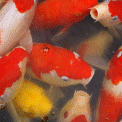|
="At the heart of most fish ponds and aquaria is the filtration system. This might be a complex, large filter such as used with koi ponds, or a simple canister often seen with aquaria. Whatever the size or shape, filters work continuously to "purify" the water. An understanding of filtration systems is important for healthy fish keeping
="Nitrification
Is a biological process during which nitrifying bacteria convert toxic ammonia nitrate.
Sources of pollution
Often there is a failure to understand just how rapidly and to what degree koi pollute the water they live in.
Organic Pollution
This form of water pollution indirectly affects koi health by encouraging high levels of opportunistic bacteria and parasites, as well as affecting overall water quality.
Removing solids from the system
If we could remove the solid wastes from the system before they had chance to dissolve and pollute the water we would have better water quality, less dissolved pollutants and fewer health problems.

Biological filtration & filter media
What's the difference between the sometimes bewildering and conflicting claims made for various filter media?
Flow rates & retention times
Although a detailed understanding of filtration mechanics is not essential, this page does explain why some filters work better than others. Retention times are more important in cases where the water is not allowed to re-enter into the filtration system a second and third time. With proper turnover, nitrogen is reduced in several passes and very few systems need worry about retention times unless they are not reuse systems. Still, there are a lot of over-stocked koi ponds with pretty poor filtration systems.
|



